Name
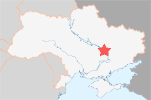
| ||
| Dnepropetrovsk |
Днепропетровск (Dnepropetrovsk) - that's the Russian name. The Ukrainian name of the town is almost identical: Днїпропетровск (Dnipropetrovsk). However, since Russian is more common in this area than Ukrainian, the Russian name will be used on this site. The city is rather young and was founded in 1776 by order of Catherine the Great aka the Second. Who else... Initially the town was named Yekaterinoslav, literally translated "Catherine's Glory". This is already the eastern part of the Ukraine, and so the atmosphere is completely different compared with towns in the west. Everything is 'more Russian' - the buildings, the people, place names etc. Russian is used more often, and many people don't even understand the Ukrainian language. Hence the Ukrainian name Dnipropetrovs'k is seldomly used - better say 'Dnepropetrovsk', which is the Russian version. Locals call the place 'Dnepro' (pron. Dnyepro).
Location
From →Kiev around 500 km downstream, some large cities straddle the Dnipro river in the south-east of the country. Among them, Dneprodzerdzinsk, Saporoshye and Dnepropetrovsk are the biggest. There's even a short subway line in the latter. However it's better to stick to marshrutkas (microbuses), trams and buses inside the town.
Population
Dnepropetrovsk has more than one million inhabitants (1.05 million to be exactly) and is the third-biggest city of the Ukraine.
Orientation
Dnepropetrovsk is an industrial town, with metallurgical industry dominating, divided into a southern and a northern part by the Dnipro (Dneper) river. The Dnepr is mostly dammed up between Chernobyl and a place some kilometers before its mouth. Only at a few places including Dnepropetrovsk, the river is not dammed up and therefore relatively narrow. Relatively means compared to other rivers in Europe - it's still one kilometer or more. The main part of the town stretches along the right (south) bank of the river. The west and the north bank is mostly dominated by industrial areas. In the east, Samara river flows into the Dneper.
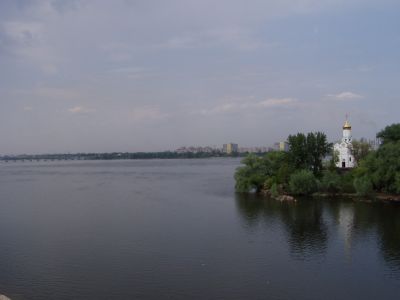
| ||
| View over the Dnipro and Monastery Island |
Getting there / transportation
Several long distance trains run to or through Dnepropetrovsk: The one to →Simferopol on the Crimean Peninsula takes around 8 hours to cover the 500 km. The fare in a kupe is around 35 UAH.
To the capital →Kiev it's 520 km. The night train needs around 12 hours. The fare for the kupe is around 42 UAH. There are also express trains (new ones), which cover the distance in less than 6 hours.
Well, they've changed the name of the town, but not the name of the main street:
просп. Карла Маркса (Karl Marx Blvd)
Beginning at the huge and palace-like main train station, straight Karl Marx Prospekt (=main street) runs parallel to the river through the centre of town sprawling out at the south bank. Administative buildings, department stores, luxurious boutiques and restaurants concentrate around the street, and so Karl Marx street is the most vibrant part of town. The middle part is around 2 kilometers long and consists of a narrow park flanked by two wide streets.
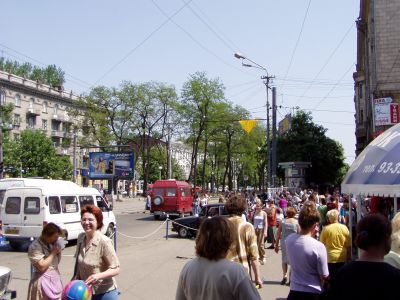
| ||
| The Karl-Marx (!) boulevard, the lively shopping street |
Benches in the small park make this place popular with locals at night and day. Curiously enough, most people do not seat on the benches but on the backrest. Why is that? Because other people sit on the rest, too, and so the seat itself is dirty. Attentive readers of this website should be able to draw a parallel - yes, it's the same as with the train toilets. In the middle, opposite the cathedral, there's the ZUM - the central department store of Dnepropetrovsk. Next to the department store is a large street market. It's hard to believe that there are many poverty-stricken people when you walk along this backbone of Dnepropetrovsk. Everything around the Karl Marx street smells of money (and the park in the middle of beer).
Диарама ???Освобождение Днепропетровска??? (Panorama of the Liberation of Dnepropetrovsk)
Almost at the eastern tip of Karl-Marx Prospekt, the beautiful campus of the Mining University faces the boulevard. Opposite the university there's a modern and ugly concrete structure surrounded by a small park. The structure houses the Panorama of the liberation of Dnepropetrovsk. For a handful of coins, you can enter the air-conditioned building and admire a dubious, semicircle battle painting while listening to the sound of a battlefield. A commited woman enthusiastically explains what was going on - a 'heroic' fight against the Nazi-German aggressors, involving 2.6 million (!) Red Army soldiers and 1.2 million Wehrmacht soldiers. Guess who won...
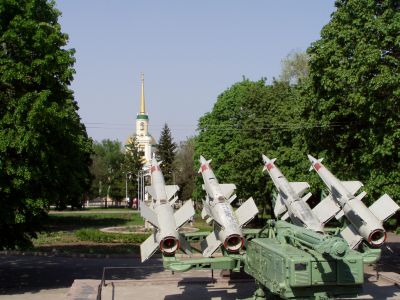
| ||
| I wonder if it's coincidence that the rockets are aimed at the church |
According to the guide, an estimated 600,000 Red Army soldiers lost their lifes. I asked about the death toll of the German army. The guide was surprised about this question and stammered something like 'I don't know...didn't think about that'. Of course it was not mentioned that this battle followed a typical Stalin philosophy à la "If we just throw in as many soldiers as possible, it's only a question of time 'till we win". What a waste of life. And - what a waste of screen and paint! Around the panorama, some old military vehicles are on display. When you walk from the panorama towards the river, you will soon get to the next highlight:
Свято???Преображенский кафедральний собор (Cathedral of the transfiguration of Christ)
This church was supposed to be a much bigger building than it is today and was dedicated to Catherine the Great (don't say you've guessed it). Unfortunately, there was not enough money, and so the wall around the church indicates the originally planned size, but the church inside is much smaller. The interior had been reconstructed a few years ago, and they didn't economise on gold leaf! I really wonder where all the money comes from! In front of the cathedral of Dnepropetrovsk as well as at any other church in the country, very poor beggars, most of them older people, are fishing for money. What a contrast - all the glittering gold inside and pure misery outside. Why is the Ukrainian church not eager to help the poor and the needy? Maybe there are some Grivna left after the last church had been gold-plated.
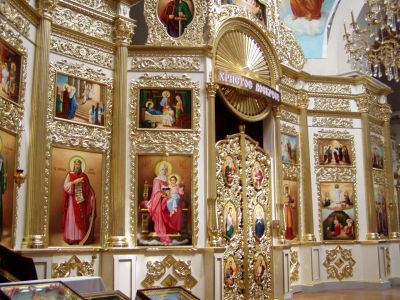
| ||
| The gold-covered Ikonostas inside the cathedral |
Not far from the church there's my favourite - the monument to the police. Next to the monument there's a glass cabin. Inside the glass cabin, policemen are stationed to protect THEIR monument, because it had been damaged several times. How do you know that a city has money to burn? Exactly. A monument for the police - what a joke. I wonder how long such a monument would survive in other countries and how much it costs to protect the monument.
остров Монастырский (Monastery Island)
Keep on going northwards from the cathedral, and you will enter the large but dirty Shevtchenko-Park. The park features some chess tables, quite popular with the locals, a House of the Youth and a large and ugly discotheque. Behind the disco is the Dneper (Dnipro river). There are many islands and islets in the middle of the river. The closest to the centre is the Komsomoltsyi Monastery Island.
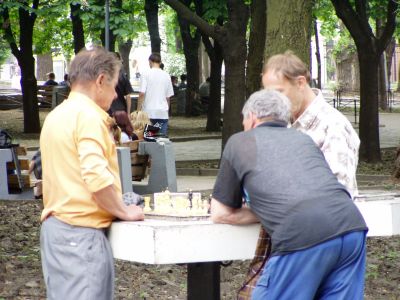
| ||
| Fancy a game of chess in the park? Quite a typical sight in Eastern European town |
For some reason they'd at least changed this name, but many people still call it 'Island of the Komsomoltsyi'. This was a powerful youth organisation in the Soviet Union - everyone had to had the chance to join the Komsomoltsyi. A small bridge leads to the long island - on the left you will see a small monastery. This might be interesting for visitors, but more interesting for locals are the beaches and all the food stalls selling Russian-style shashlik, chilled beer and vodka. A nice place to flee the hectic of the city. There's even a chair-lift from the Karl Marx-Prospekt to the island. The lift wasn't working - at least not in May.
Dnepropetrovsk offers another picture of the Ukraine and helps to complete the picture of this country. This city is completely different to Kyiv, the Crimea or the Western Ukraine. There are no real attractions, but it's still worth a visit.
We've spent the nights at a friend's place, so I can't give any recommendation on hotels. Since Dnepropetrovsk is large, there are severals hotels - for example close to the train station. Travelers are rare in this area, so it's more about business hotels.
- gorod.dp.ua/eng Webportal with pictures and information on accommodation in Dnepropetrovsk - this is the link to the English version.
Do you have or do you know a good website about Dnepropetrovsk? Don't hesitate, let me know! After checking it, I would love to add it to the link list. You can submit a link by using the →contact form. Note that commercial websites will be treated differently.
©2024 Europe-East.com

 Albania
Albania Ukraine
Ukraine